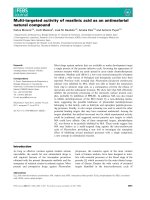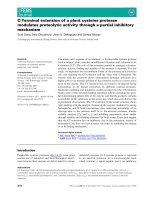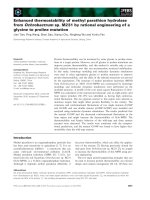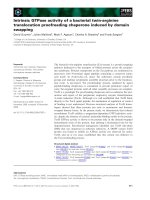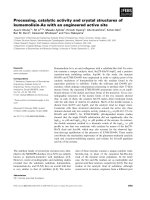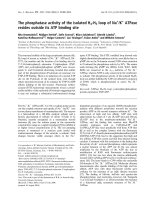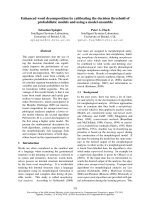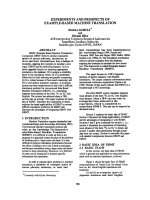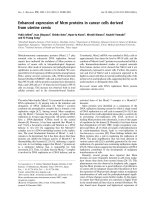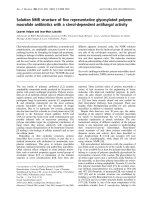Báo cáo khoa học: "Enhanced anti-HCV activity of interferon alpha 17 subtype" ppt
Bạn đang xem bản rút gọn của tài liệu. Xem và tải ngay bản đầy đủ của tài liệu tại đây (396.88 KB, 10 trang )
BioMed Central
Page 1 of 10
(page number not for citation purposes)
Virology Journal
Open Access
Research
Enhanced anti-HCV activity of interferon alpha 17 subtype
Aurelie Dubois
1
, Catherine François
1
, Veronique Descamps
1
,
Carole Fournier
1
, Czeslaw Wychowski
2
, Jean Dubuisson
2
,
Sandrine Castelain
1
and Gilles Duverlie*
1
Address:
1
Virology Laboratory-Amiens University Medical Centre, France and
2
CNRS-UMR 8161, Lille Institute of Biology, Lille, France
Email: Aurelie Dubois - ; Catherine François - ;
Veronique Descamps - ; Carole Fournier - ;
Czeslaw Wychowski - ; Jean Dubuisson - ; Sandrine Castelain - sandrine.castelain@u-
picardie.fr; Gilles Duverlie* -
* Corresponding author
Abstract
Background: Pegylated interferon alpha 2 (a or b) plus ribavirin is the most effective treatment
of chronic hepatitis C but a large proportion of patients do not respond to therapy. So, it is
interesting to improve the treatment efficacy. Interferon alpha is a type I interferon composed of
12 different subtypes. Each subtype signals by the Jak-Stat pathway but modulations in the antiviral
activity was previously described.
Methods: Using the hepatitis C virus (HCV) culture system, we have tested the anti-HCV activity
of each interferon alpha subtypes. We have analyzed the effect of each subtype on the HCV
multiplication and the cell-signaling pathway for some subtypes.
Results: There were divergent effects of IFN alpha subtypes against HCV. We have found that IFN
alpha 17 was three times more efficient than IFN alpha 2a on HCV. This efficiency was related to
a stronger stimulation of the Jak-Stat pathway.
Conclusion: We suggest that IFN α17 should be tested therapeutically with a view to improving
treatment efficacy.
Background
The hepatitis C virus (HCV) is one of the main known
causes of liver diseases such as cirrhosis and hepatocellu-
lar carcinoma (HCC) [1,2]. Infection with HCV is a major
public health problem; it has been estimated that 3% of
the world's population is chronically infected. Indeed, in
many countries, HCV is the most common cause for liver
transplantation [3,4]. Current therapy is based on
pegylated interferon alpha 2a or 2b, in combination with
ribavirin [3]. Nevertheless, combination therapy is not
fully effective (with only approximately 55% of patients
showing a sustained virological response) and its frequent
side-effects reduce health-related quality of life in many
patients [5]. Improvement of HCV therapy implies (i) to
gain a better understanding of the mechanism of action of
current treatments and (ii) to develop novel anti-HCV
molecules [6,7]. Recent data concerning new molecules
(such as anti-polymerases and anti-proteases) used in
monotherapy have shown that escape mutants are rapidly
selected for. Hence, administering these molecules in
Published: 3 June 2009
Virology Journal 2009, 6:70 doi:10.1186/1743-422X-6-70
Received: 6 February 2009
Accepted: 3 June 2009
This article is available from: />© 2009 Dubois et al; licensee BioMed Central Ltd.
This is an Open Access article distributed under the terms of the Creative Commons Attribution License ( />),
which permits unrestricted use, distribution, and reproduction in any medium, provided the original work is properly cited.
Virology Journal 2009, 6:70 />Page 2 of 10
(page number not for citation purposes)
combination with interferon may be one way of improv-
ing treatment efficacy [8-11].
Interferon alpha (IFN-α) is a cytokine that has many bio-
logical properties; it is antiviral and antiproliferative and
stimulates cytotoxic activity in a variety of immune system
cells [12]. Interferon alpha is a member of the type I inter-
feron family, comprising cytokines that bind to the same
receptor (the interferon α/β receptor, IFNAR) to initiate a
signaling response [13]. Several subtypes of IFN-α (12
proteins encoding by 14 genes) and many allelic variants
have been described. Interferon alpha subtypes exhibit a
very high degree of amino-acid similarity (over 75%) but
the reason for the existence of so many distinct proteins is
still unknown [12,13]. Although each subtype displays a
unique activity profile [12,14], only IFN-α2a and IFN-α2b
subtypes are currently used for the treatment of chronic
HCV infection. After binding to the IFNAR, IFN-α signals
mainly through the Jak-Stat pathway. The Janus kinases
Jak-1 and Tyk-2 are then phosphorylated and, in turn,
phosphorylate STAT proteins, which multimerize and
associate with IRF-9 to form ISGF3 (interferon-stimulated
gene factor 3). This complex translocates to the nucleus
and targets the ISRE (interferon-stimulated response ele-
ment) sequences present within the promoters of inter-
feron-stimulated genes (ISGs) coding for (amongst
others) a number of antiviral proteins, including the well-
characterized antiviral PKR protein (double-stranded
RNA-dependent protein kinase), 2'-5' oligoadenylate syn-
thetase (2-5OAS) and MxA [15].
Several studies have focused on the differing degrees of
antiviral action produced by the various IFN-α subtypes.
Foster et al. have shown that IFN-α8 was the most potent
subtype in various human cell lines infected with murine
encephalomyocarditis virus (EMCV), whereas IFN-α1 had
very little antiviral effect in the same system [16]. These
results were confirmed by Yamamoto et al. in human
hepatic cell lines infected by vesicular stomatitis virus
(VSV) [17]. The antiviral effects of IFN-α subtypes on HCV
has also been studied using subgenomic replicons [18].
Koyama et al. have demonstrated that the various IFN-α
subtypes differ in terms of their anti-HCV actions and that
IFN-α8 was the most effective inhibitor of intracellular
HCV replication. These authors' results suggest that this
differential effect may be exerted through JAK-STAT-inde-
pendent pathways [19].
The recently developed HCV cell culture (HCVcc) system
uses a JFH-1 genotype 2a strain of HCV and enables inves-
tigation of the overall viral life cycle [20]. In the present
work, we used this system to determine the anti-HCV
activity of twelve recombinant IFN-α subtypes. The antivi-
ral action of each subtype was compared with that of IFN-
α2a (i.e. the subtype used in therapy) by measuring intra-
cellular viral replication and the production of infectious
virions. Having found that IFN-α17 displayed the highest
anti-HCV activity, we then explored the transduction
pathways which could explain this heightened ability.
Our results show that IFN-α17's anti-HCV activity may be
accounted for by stronger activation of the JAK-STAT path-
way and thus higher antiviral protein expression levels.
Methods
Cell culture and viral infection
Huh7 human hepatoma cells were cultured in Dulbecco's
modified Eagle's medium (DMEM) (Jacques Boy, Reims,
France) supplemented with 10% fetal calf serum and
maintained in 5% CO
2
at 37°C. JFH-1 viral stock prepara-
tion and titration were performed exactly as described pre-
viously [21].
Recombinant interferon alpha subtypes
All the recombinant IFN-α subtypes (α1, α2a, α4, α5, α6,
α7, α8, α10, α14, α16, α17 and α21) were obtained from
the human IFN sampler (PBL Biomedical Laboratories,
Piscataway, NJ). It includes 2.10
5
units/mL of each sub-
type of IFN-α. The concentration in pg/mL was taken into
account for each subtype. The interferon subtypes were
quantified using the VSV challenge assay on MDBK cells,
as supplied by the manufacturer (Table 1).
Table 1: Specific activity of each interferon alpha subtype.
IFN-α subtype Specific activity (IU/mg) IFN-α subtype Specific activity (IU/mg)
IFN-α 1 (D) 7.5.10
7
IFN-α 8 (B2) 4.95.10
8
IFN-α 2a (A) 3.85.10
8
IFN-α 10 (C) 2.31.10
8
IFN-α 4b 1.8.10
8
IFN-α 14 (H2) 1.05.10
8
IFN-α 5 (G) 2.33.10
8
IFN-α 16 (WA) 2.4.10
8
IFN-α 6 (K) 1.48.10
8
IFN-α 17 (I) 1.4.10
8
IFN-α 7 (J1) 2.56.10
8
IFN-α 21 (F) 6.3.10
8
All specific activities were given by the manufacturer and were titrated by using a cytopathic effect inhibition assay. The units are determined with
respect to international reference standard for human interferon alpha α provided by the National Institutes of Health. Units of activity were
measured in bovine MDBK cells with vesicular stomatitis virus (VSV).
Virology Journal 2009, 6:70 />Page 3 of 10
(page number not for citation purposes)
Determination of anti-HCV efficacy
Huh7 cells were infected with JFH-1 at a multiplicity of
infection (MOI) of 0.001. After three weeks of infection,
chronically infected cells were seeded in 24-well plates at
a density of 70,000 cells/well in medium (DMEM supple-
mented with 10% fetal calf serum) containing different
IFN-α subtypes at a concentration of 260 pg/mL. After 48
hours of incubation at 37°C, the supernatants were har-
vested and the virus yield was measured using a focus-
forming unit (FFU) assay. The cells were washed twice
with phosphate-buffered saline (PBS) and then
trypsinized in order to perform HCV RNA quantification.
Intracellular HCV RNA quantification
Total RNA was extracted from the cells using the RNeasy
Mini kit ("Animal cell spin" protocol) from Qiagen
(Courtaboeuf, France), according to the manufacturer's
instructions. HCV RNA quantification was performed
with a real-time RT-PCR assay, as previously described
[22]. At the same time, β-actin RNA was quantified by
including 1.25
μ
L of human β-actin mix (Applied Biosys-
tems, Coutaboeuf, France) in the PCR mix reaction
instead of the HCV primers and probe. Each IFN-α sub-
type's inhibitory activity on the JFH-1 strain was calcu-
lated by using β-actin gene as a housekeeping gene and
applying the comparative C
t
method, as previously
described [23].
Viral yield assay (FFUs)
35,000 cells were seeded into 24-well plates and infected
with the supernatants at different dilutions (1 to 10
-2
).
After 6 hours of incubation, the medium was replaced
with fresh medium (DMEM supplemented with 10% fetal
calf serum). After 3 days, an immuno-peroxydase reaction
was performed as previously described [21]. Focus-form-
ing units were counted for each dilution and normalized
to 1 mL
IFN subtype IC
50
determination
50,000 Huh7 cells were seeded into 24-well plates and
infected with 200
μ
L of the JFH-1 strain (MOI = 0.1) at dif-
ferent dilutions (10
-2
to 10
-4
). After 18 hours of incuba-
tion, the medium was replaced by fresh medium
containing IFN-α subtypes at different concentrations (0,
1.3, 2.6, 5.2, 13 and 26 pg/mL). After 2 days of culture,
FFUs were quantified, as previously described. The con-
centration that inhibited 50% of the yield (i.e. the IC
50
)
was calculated for each condition.
Interferon-stimulated response element luciferase reporter
assay
Huh7 cells were seeded into 96-well plates at a density of
20,000 cells per well. The following day, the culture
medium was replaced by fresh medium. Fours hour later,
each well was transfected with 250 ng of the pMx-GFP-luc
plasmid by using the calcium phosphate precipitation
technique (CalPhos Mammalian Transfection kit, Clon-
tech, Saint-Germain en Laye, France) according to the
manufacturer's instructions. The plasmid had been con-
structed by inserting the human MxA promoter [24] into
the pEGFPLuc vector (Clontech). On the following day,
IFNs were applied to the culture medium at various con-
centrations (0, 26 and 260 pg/mL). After 18 hours, cells
were lysed and luciferase activity was quantified using the
Luciferase Assay System (Promega, Charbonnieres-les-
bains, France) in a luminometer (Lumat, Berthold,
Thoiry, France).
Transcriptome studies using a low-density array
300,000 chronically-infected Huh7 cells were seeded into
6-well plates and incubated with IFN-α2a, IFN-α17 or
IFN-α1 (at 260 pg/mL in all cases). After 48 hours, total
RNA was extracted from the cells and reverse-transcribed
into cDNA, as previously described. The TaqMan
®
Low
Density Array (TLDA) is a 384-well microfluidic card that
enables the performance of 384 simultaneous real-time
PCRs. Each 2-
μ
l well contains specific, user-defined prim-
ers and probes capable of detecting a single gene. In the
present study, the TLDA card was configured into two 96-
gene sets which enabled analysis of gene expression in 2
different conditions. These genes (chosen on the basis of
the literature) were present in duplicate and were all
expressed under the control of the ISRE [25]. One hun-
dred ng of each cDNA sample were mixed with an appro-
priate buffer (TaqMan Universal PCR Master Mix from
Applied Biosystems), and was transferred into a loading
port on the TLDA card. The card was then sealed and PCR
amplification was performed using an Applied Biosys-
tems Prism 7900HT sequence detection system. The ΔΔCt
method was used for analysis after normalization to β-
actine expression.
Western blot analysis
IFNs were added to chronically-infected Huh7 cells at
increasing concentrations (0.26, 2.6, 26 and 260 pg/ml)
for either 30 minutes or 24 hours. At the indicated time
point, cells were washed twice with cold PBS, harvested
and then lysed using a buffer (1% NP40, 10% glycerol, 50
mM Tris-HCl pH 7.5, 150 mM NaCl and 0.5 mM PMSF)
containing a phosphatase inhibitor cocktail (Sigma
Aldrich, France) diluted to 1:100. Total cellular extracts
were separated by SDS-PAGE electrophoresis and trans-
ferred to nitrocellulose membranes. The membranes were
then incubated overnight at 4°C with the primary anti-
bodies. The blots were developed with the chemilumines-
cence (ECL) system (GE Healthcare) using specific
peroxydase conjugated anti IgG (GE Healthcare, Saclay,
France) antibodies. The anti-MxA monoclonal antibody
(Mab) was a gift from Dr I. Julkunen (Department of Viral
Diseases and Immunology, National Public Health Insti-
Virology Journal 2009, 6:70 />Page 4 of 10
(page number not for citation purposes)
tute, Helsinki, Finland). Anti-Stat1 and anti-
PStat1(Tyr701) antibodies were purchased from Cell Sig-
naling Technology and anti-β actin (C4) Mab was pur-
chased from Santa Cruz Biotechnology (Tebu Bio, Le
Perray en Yvelines, France).
Statistical analysis
Statistical data analyses were performed using Student's T
test. P-values of 0.05 or less were considered to be signifi-
cant.
Results
Antiviral activity of different IFN
α
subtypes on chronic
HCV replication and multiplication
Each IFN-α subtype exhibits a characteristic antiviral pro-
file. Hence, we compared the respective anti-HCV activi-
ties of IFN-α subtypes obtained from the human IFN
sampler. Two parameters were considered. Firstly, viral
replication after treatment of infected Huh7 cells with 260
pg/mL of each IFN-α was measured by quantifying intrac-
ellular HCV RNA. The fold inhibition was then calculated,
as described in the Materials and Methods section. As
Inhibition of HCV replication and multiplication by different IFN-α subtypesFigure 1
Inhibition of HCV replication and multiplication by different IFN-α subtypes. A: Total RNA from Huh7-infected
cells cultured with 260 pg/mL of different IFN α subtypes was used to quantify HCV intracellular RNA, as described in the
Materials and methods. The inhibition was calculated by comparing the results to infected Huh7 cells in the absence of inter-
feron. An asterisk indicates represents the IFN subtypes that were significantly more potent against HCV than IFN-α2a. B:
Quantification of HCV multiplication by measuring the viral yield in the supernatant. The results were expressed in FFU/mL on
a semi-logarithmic scale. An asterisk indicates the IFN subtypes that were significantly more potent against HCV than IFN-α2a.
The results correspond to the mean of four independent experiments.
0,001
0,01
0,1
1
IFN
neg 1 6 16 4b 14 2a 5 21 10 8 7 17
IFN alpha subtypes (260 pg/mL)
Inhibition (log)
**
*
1
10
100
1000
10000
IFN
neg
12a7 817
interferon alpha subtypes (260 pg/mL)
FFU/mL
*
A
B
Virology Journal 2009, 6:70 />Page 5 of 10
(page number not for citation purposes)
shown in Figure 1a, all IFN-α subtypes inhibited HCV rep-
lication (p < 0.05). A classification of the anti-HCV activ-
ity of IFN-α subtypes was carried out by comparing the
values with the fold inhibition displayed by IFN-α2a.
Three subtypes appeared to have greater activity against
HCV: IFN-α17 (p < 0.001 versus IFN-α2a), -α7 (p < 0.005
versus IFN-α2a) and -α8 (p < 0.005 versus IFN-α2a). The
other subtypes (notably IFN-α1) had modest effects on
HCV replication.
Secondly, HCV multiplication was measured using the
FFU technique. As shown in Figure 1b, only IFN-α17 was
significantly most potent than IFN-α2a, and the results
showed a correlation between the activity of IFN-α sub-
types on viral replication and that on viral production.
However, IFN-α17 stood out due to its major anti-HCV
activity.
Determination of the inhibitory concentration 50% (IC
50
)
for IFN-
α
subtypes 2, 17 and 1
In order to confirm the above results and analyze the
action of certain subtypes, we determined the IC
50
(the
concentration of IFN-α required to decrease the produc-
tion of infectious virions by half) for IFN-α2a, α17 and
α1. Huh7 cells were infected with HCV-JFH1 and various
concentrations of IFNs were added on the following day.
Viral yields were then measured using an FFU assay and
viral titers were expressed as a percentage relative to the
IFN-free control well. As shown in Figure 2, the IC
50
values
for IFN-α2a and IFN-α17 were 14.6 pg/mL and 4.8 pg/
mL, respectively. This was equivalent to about a 3-fold
enhancement in activity. However, IFN-α1 had poor anti-
HCV activity because a concentration of over 25 pg/mL
was required to obtain the same degree of antiviral action
as with IFN-α2a. The greater anti-HCV activity of IFN-α17
was thus confirmed.
Stimulation of the ISRE-dependent gene by different IFN-
α
subtypes
Two IFN-α subtypes stood out as a result of the antiviral
activity studies: IFN-α17 and IFN-α1. The former was par-
ticularly potent against HCV and the latter had very low
activity. We thus sought to explore the antiviral mecha-
nism of each IFN-α subtype. Induction of the Mx pro-
moter (mainly activated by ISRE elements) was first
studied. As shown in Figure 3, all the tested IFNs subtypes
activated the Mx promoter (via the Jak-Stat pathway) but
to differing extents. The Mx promoter was notably less
activated by IFN-α1 than by the other subtypes. At the two
INF-α concentrations tested (26 pg/mL and 260 pg/mL),
only IFN-α17 induced better stimulation of the Mx pro-
moter than IFN-α2a did (p < 0.002 and p < 0.007 for 26
and 260 pg/mL, respectively).
In order to confirm the involvement of the Jak-Stat path-
way, we analyzed the tyrosine phosphorylation status of
the Stat1 protein. As shown in Figure 4, Stat1 phosphor-
ylation was higher with IFN α17 than with IFN α2 at the
same concentration. Altogether, these results suggest that
IFN α17 is a stronger activator of the Jak-Stat pathway.
Enhanced induction of antiviral proteins by IFN
α
-17
In order to explore the consequences of modulation of the
Jak-Stat pathway by the different IFNα subtypes, IFN-reg-
ulated gene expression was explored using the TLDA.
Comparative gene expression studies (IFN-α2a vs. IFN-
α17 and IFN-α2a vs. IFN-α1) were carried out as
described in the Materials and Methods section. As shown
in Table 2, most of the genes induced by IFN-α17 treat-
ment were well-characterized antiviral genes, such as the
MxA, PKR, ADAR and OAS genes. Other highlighted genes
(such as GBP1 or IFI27) may play a role in HCV replica-
tion [26,27]. Other genes have been described as being
involved in interferon induction (DDX-58) or encoding
Determination of the IC50% for three IFN-α subtypesFigure 2
Determination of the IC50% for three IFN-α sub-
types. Huh7-infected cells were cultured with or without
different concentrations (in pg/mL) of IFN-α2a (open circles),
IFN-α17 (closed squares) and IFN-α1 (open triangle). The
virus yield was determined using the FFU method. The
results represent the mean of four independent experiments.
The p values were < 0.05 at all concentrations for the IFN-
α2a vs. IFN-α17 comparison (*) and at 12.5 and 25 pg/mL for
the IFN-α2a vs. IFN-α1 comparison (+).
Virology Journal 2009, 6:70 />Page 6 of 10
(page number not for citation purposes)
proteasome subunits (PSMB8, PSMB9). Stronger expres-
sion of antiviral genes suggests stronger induction of the
Jak-Stat pathway after IFN-α17 treatment. The above-
mentioned genes were strongly less induced after treat-
ment by IFN-α1 (up to 50-fold, see Table 2). To confirm
these results, MxA protein expression was studied by
Western blot analysis. As shown in Figure 5, MxA protein
was not induced by IFN-α1 concentrations of 260 pg/ml
or less. At equal IFN-α concentrations, MxA protein was
more strongly induced by IFN-α17 than by IFN-α2a.
Discussion
Viral clearance in treated, chronically-infected HCV
patients occurs in only about 55% of cases. At present, the
standard therapy is a ribavirin-PEG-IFNα2 combination.
Although the synergistic mechanism of action of this com-
bination is not clearly understood [28], it is clear that ther-
apeutic optimization is needed to increase the number of
sustained virological responders. The aim of the present
study was to determine the differential anti-HCV activity
of the twelve main IFNα subtypes. We used the HCVcc
system to study the subtypes' overall antiviral effects on
the HCV life cycle.
We first tested the anti-HCV activity of the different IFNα
subtypes by measuring the production of intracellular
HCV RNA. Three subtypes (IFN α17, IFN α7 and IFN α8)
were significantly more potent than IFN α2. These results
are in accordance with other work demonstrating that IFN
α8 has good antiviral activity against EMCV and HCV
[16,19]. Little information on IFN α7 is available,
although it displayed at least the same anti-HCV efficacy
as IFN α2 in our study. This result was confirmed in terms
of inhibition of the production of infectious particles,
where IFN α17 was three times more potent than IFN α2.
Again, this result agrees with previous work reporting that
a variant of the IFN α17 subtype was more potent than
IFN α2, although a comparison between the variant and
the wild subtype was not presented [29]. Our study also
confirmed the weak antiviral effect of IFN α1.
Stimulation of the Mx promoter by the different IFN-α subtypesFigure 3
Stimulation of the Mx promoter by the different IFN-α subtypes. Huh7 cells were transfected with a plasmid contain-
ing the luciferase reporter gene under the control of the human Mx promoter. After stimulation by IFN-α2a, 17, 8, 7 and 1,
luciferase was quantified. The results correspond to the ratio between the value obtained with IFN-α and the value obtained in
the absence of interferon and were the mean of two independent experiments in triplicate. An asterisk indicates the values
that were significantly different from those for IFN-α2a at the same concentration.
Virology Journal 2009, 6:70 />Page 7 of 10
(page number not for citation purposes)
Concerning the mechanism of action, IFNα signaling is
mainly related to the Jak-Stat pathway. Here, we sought to
determine whether or not the higher activity of some sub-
types was related to modified stimulation of the Jak-Stat
pathway. As shown in the Results section, IFN α17 and
IFN α7 prompted better stimulation of the ISRE-depend-
ent genes than IFN α2 did at the same concentration. In
contrast, IFN α1 was a poor activator of the Jak-Stat path-
way. A Stat1 tyrosine phosphorylation study confirmed
that the Jak-Stat pathway modulation was differentially
modulated by the various different IFN α subtypes. This
suggested that the Jak-Stat pathway was being modulated
upstream of Stat phosphorylation. Recent work has
detailed the interaction between IFN α2 and its receptor.
IFN α2 binds first to IFNAR2 and then recruits IFNAR1.
After formation of the ternary complex, the interferon sig-
nal is transduced via receptor-associated JAK kinases [30].
Three point mutations increase IFN α2's binding affinity
for IFNAR1: H57A, E58A, Q61A. These residues were seen
to be conserved in IFN α subtypes and were responsible
for the differences in action between IFN β and IFN α [30].
Hence, it seems that modulation of IFN's affinity for the
Analysis of Stat1 phosphorylationFigure 4
Analysis of Stat1 phosphorylation. A Western blot analysis was performed with monoclonal antibodies directed against
specific tyrosine phosphorylation sites on Stat1 (Tyr701). The cells were treated with four concentrations of interferon (0.26,
2.6, 26 or 260 pg/ml) or not treated at all. The input control is represented by the Stat1 and the actin immunoblot.
Stat1 P
Stat1
IFN 2a IFN 17
Actin
00
Induction of MxA protein by IFN-α2a, 17 and 1Figure 5
Induction of MxA protein by IFN-α2a, 17 and 1. Huh7 cells were treated with the same interferon concentrations as in
Figure 4. The MxA protein was detected by immunoblotting. The input control is represented by the actin protein.
MxA
Actin
IFN 2a IFN 17 IFN 1
000
Virology Journal 2009, 6:70 />Page 8 of 10
(page number not for citation purposes)
IFNAR1 induces an antiproliferative effect rather than
modulating antiviral activity per se [30]. For IFNAR2, six
hotspot residues for IFN α2's binding to IFNAR2 were
highlighted (30, 33, 144, 147, 148 and 149) [31] but are
conserved in all IFN α subtypes [32]. The weak effect of
IFN α1 may be explained by the K31M mutation, which
might disrupt the IFNα-IFNAR2 interaction [33]. A recent
study of the interferon C-terminus domain has demon-
strated that the tail residues are poorly conserved between
the different IFN α subtypes and between IFN α and IFN
β [34]. Moreover, major differences in the different tails'
net charge were observed: IFN α2 has a net charge of 0 and
IFN α8 and IFN α17 both have a net charge of 3. The
replacement of IFN α2's tail by an IFN α8 tail increased
the binding of IFN α2 to IFNAR2 by a factor of 20 and
translated into nine-fold higher antiproliferative activity
and four-fold higher antiviral activity [34]. These results
are in agreement with our own, since IFN α17 and IFN α8
presented the greatest anti-HCV activity. Hence, it is pos-
sible that the differences between IFN α17, IFN α1 and
IFN α2 in terms of antiviral activity could be due to differ-
ing affinities for the IFNAR2.
Table 2: ISG-RNA expression for IFN-α17 and IFN-α1, relative to
IFN-α2a.
Detector Alpha 17 Alpha1
18S-Hs99999901_s1 1.01 1.01
ADAR-Hs00241666_m1 0.99 0.80
ALCAM-Hs00233455_m1 0.90 1.05
APOL1-Hs00358603_g1 2.28 0.26
BAK1-Hs00832876_g1 0.86 0.95
CCL5-Hs00174575_m1 1.44 0.07
CD47-Hs00179953_m1 1.28 0.78
CXCL10-Hs00171042_m1 1.42 0.43
CXCL9-Hs00171065_m1 5.89 0.83
DDX58-Hs00204833_m1 1.28 0.48
EIF2AK2-Hs00169345_m1 0.92 0.50
FAS-Hs00236330_m1 0.89 0.60
FAS-Hs00531110_m1 0.48 0.54
G1P2-Hs00192713_m1 1.20 0.23
GAPDH-Hs99999905_m1 0.90 1.09
GBP1-Hs00266717_m1 1.15 0.46
GBP2-Hs00269759_m1 0.91 0.99
ICAM1-Hs00164932_m1 0.81 0.68
IFI27-Hs00271467_m1 3.07 0.04
IFI35-Hs00382709_m1 1.06 0.64
IFI35-Hs00413458_m1 1.09 0.56
IFI44-Hs00197427_m1 1.72 0.50
IFIH1-Hs00223420_m1 1.37 0.21
IFIT1-Hs00356631_g1 1.32 0.22
IFIT2-Hs00533665_m1 1.36 0.75
IFIT3-Hs00155468_m1 1.46 0.41
IFIT5-Hs00202721_m1 1.39 0.42
IFITM1-Hs00705137_s1 1.37 0.56
IFNAR1-Hs00265057_m1 0.90 1.10
IFNAR2-Hs00174198_m1 0.92 1.01
IL15-Hs00542571_m1 0.62 1.18
IL15RA-Hs00542604_m1 6.85 2.38
IL1B-Hs00174097_m1 1.18 0.71
IL6-Hs00174131_m1 0.97 0.45
IL8-Hs00174103_m1 1.28 0.89
IRF1-Hs00233698_m1 0.83 0.78
IRF2-Hs00180006_m1 0.94 1.09
IRF3-Hs00155574_m1 0.95 1.43
IRF4-Hs00180031_m1 0.85 0.61
IRF4-Hs00277069_m1 4.35 1.01
IRF5-Hs00158113_m1 1.05 0.02
IRF5-Hs00158114_m1 0.88 0.17
IRF8-Hs00609879_m1 0.59 1.25
ISG20-Hs00158122_m1 0.96 0.83
ISGF3G-Hs00196051_m1 0.96 0.51
MPO-Hs00165162_m1 1.24 0.84
MX1-Hs00182073_m1 1.33 0.07
MX2-Hs00159418_m1 1.01 1.16
MYD88-Hs00182082_m1 1.01 0.81
NFKBIA-Hs00153283_m1 0.85 0.93
NMI-Hs00190768_m1 1.18 0.80
OAS1-Hs00242943_m1 1.38 0.15
OAS2-Hs00159719_m1 2.28 0.02
OAS2-Hs00213443_m1 2.72 0.03
OAS3-Hs00196324_m1 1.18 0.17
OASL-Hs00388714_m1 1.93 0.05
PLSCR1-Hs00275514_m1 1.08 0.58
PML-Hs00231241_m1 1.17 0.80
PRKRA-Hs00269379_m1 0.96 1.13
PSMB10-Hs00160620_m1 1.08 0.93
PSMB8-Hs00188149_m1 1.86 0.92
PSMB8-Hs00544758_m1 1.83 0.48
PSMB9-Hs00160610_m1 0.96 2.44
PSMB9-Hs00544762_m1 1.93 0.05
PSMD8-Hs00601309_m1 1.06 1.14
PSME1-Hs00389209_m1 0.94 0.86
PTPRC-Hs00236304_m1 0.56 1.39
RELA-Hs00153294_m1 0.96 0.87
RELB-Hs00232399_m1 1.21 0.88
RSAD2-Hs00369813_m1 2.17 0.12
SP110-Hs00185406_m1 1.07 0.49
SP110-Hs00270142_m1 1.19 0.37
STAT1-Hs00234829_m1 1.03 0.53
STAT2-Hs00237139_m1 1.05 0.68
STAT3-Hs00374280_m1 0.93 1.02
STAT4-Hs00231372_m1 1.21 0.77
STAT5A-Hs00234181_m1 1.11 0.82
STAT5B-Hs00560035_m1 0.85 1.00
TNFSF10-Hs00234356_m1 0.98 0.82
TRADD-Hs00601065_g1 0.61 1.02
TRIM21-Hs00172616_m1 0.96 0.67
TRIM25-Hs00231947_m1 0.94 0.68
USP18-Hs00276441_m1 1.24 0.62
An ISG low-density array assay was performed with a concentration
of 260 pg/mL of IFN. Indicated values are the mean of two
independent experiments and represent the fold induction. The
column named IFN-α17 corresponds to the comparison between
IFN-α17 and IFN-α2a. The column named IFN-α1 corresponds to the
comparison between IFN-α1 and IFN-α2a. Bold-faced values
represent the genes strongly regulated by these two interferon
compared to IFN-α2a. The detector column is the name of the gene
follow by the Applied Biosytems references of the test.
Table 2: ISG-RNA expression for IFN-α17 and IFN-α1, relative to
IFN-α2a. (Continued)
Virology Journal 2009, 6:70 />Page 9 of 10
(page number not for citation purposes)
However, potential differences in affinity for the receptor
cannot explain the totality of IFN α8's effect, where no sig-
nificant increase in activation of the ISRE-dependent path-
way was seen. Foster et al. have demonstrated that IFN α8
conserved this activity in U1A cells that do not contain
Tyk2, a protein that is essential for IFN signal transduction
[16]. Other pathways (such as the PI3K and p38 kinase
pathways) have emerged as critical additional compo-
nents of IFN-induced signal transduction [35]. For IFN
α17, the increase in Jak-Stat signaling appears to be the
main reason for its higher antiviral activity but stimula-
tion of other pathways cannot be ruled out.
In addition, interferon's antiviral activity may depend on
the cell type. In the present study, we used Huh7 cells,
since these are the only currently permissive cell line for
HCV replication in the HCVcc system. One could hypoth-
esize that the difference in antiviral activity is explained by
greater sensitivity of the Huh7 cells to IFN α17. However,
very similar results were obtained with bovine Madin-
Darby bovine kidney (MDBK) cells containing the chlo-
ramphenicol acetyl transferase (CAT) gene under the con-
trol of the MxA promoter [36]. It is difficult to say whether
the activity differences between the IFN subtypes were due
to the cell types or the viruses or both. However, we can
hypothesize that the differences of activity are based on
the virus type. For instance, the human MxA protein can
induce protection against influenza virus or VSV [37]. PKR
and 2-5A synthetases were both shown to be involved in
resistance to EMCV but not VSV [38,39]. In this case, ISG
induction could be modulated by the IFN subtypes and
the transcriptome study may evidence modulation of anti-
viral-ISG expression and then subtype-specific modula-
tion of the antiviral state. However, it is difficult to
imagine how gene-by-gene modulation could be per-
formed by induction of the Jak-stat pathway alone. Hence,
cell type could be a factor – perhaps via modulation of the
different IFN subtypes' affinity for the IFN receptor (as dis-
cussed above) or by stimulation of pathways other than
Jak-Stat.
There are few available data on the production of IFN
α17. In the context of HCV infection, IFN α5 is the major
subtype produced in the liver and by the peripheral blood
mononuclear cells (PBMCs) [35]. Hence, natural antiviral
activity in the liver does not seem to be optimal in
response to HCV infection, when combined with poor
induction of the endogenous pathway [40].
Conclusion
IFN α17 was the IFN α subtype that had the greatest anti-
HCV activity in Huh7 cells. It was about three times more
potent than the IFN α2 currently used in the clinic and
this effect could be explained by stronger stimulation of
the Jak-Stat pathway. We suggest that IFN α17 should be
tested therapeutically with a view to improve treatment
efficacy. It would also be interesting to test the synergy
between IFN α17 and ribavirin.
Competing interests
The authors declare that they have no competing interests.
Authors' contributions
CFr and GD conceived, designed and wrote the paper. AD
performed the analysis. VD and CFo gave their technical
assistance for quantitative RT-PCR and virus assay. SC and
CFr performed the statistical analysis. CW and JD have
given final approval for the version to be published.
Acknowledgements
This work was funded by the "Programme Hospitalier de Recherche Cli-
nique de Picardie"(PHRC, 2004) and by the Agence Nationale de Recher-
che sur le SIDA (ANRS). We thank David Fraser for English corrections.
References
1. Wasley A, Alter MJ: Epidemiology of hepatitis C: geographic
differences and temporal trends. Semin Liver Dis 2000, 20:1-16.
2. Alter MJ: The epidemiology of acute and chronic hepatitis C.
Clin Liver Dis 1997, 1:559-568.
3. NIH Consensus Statement on Management of Hepatitis C:
2002. NIH Consens State Sci Statements 2002, 19:1-46.
4. Chen SL, Morgan TR: The natural history of hepatitis C virus
(HCV) infection. Int J Med Sci 2006, 3:47-52.
5. Younossi Z, Kallman J, Kincaid J: The effects of HCV infection and
management on health-related quality of life. Hepatology 2007,
45:806-816.
6. Chevaliez S, Pawlotsky JM: Hepatitis C virus: virology, diagnosis
and management of antiviral therapy. World J Gastroenterol
2007, 13:2461-2466.
7. Pawlotsky JM: Therapy of hepatitis C: from empiricism to
eradication. Hepatology 2006, 43:S207-220.
8. Forestier N, Reesink HW, Weegink CJ, McNair L, Kieffer TL, Chu
HM, Purdy S, Jansen PL, Zeuzem S: Antiviral activity of telaprevir
(VX-950) and peginterferon alfa-2a in patients with hepatitis
C. Hepatology 2007, 46:640-648.
9. Kieffer TL, Sarrazin C, Miller JS, Welker MW, Forestier N, Reesink
HW, Kwong AD, Zeuzem S: Telaprevir and pegylated inter-
feron-alpha-2a inhibit wild-type and resistant genotype 1
hepatitis C virus replication in patients. Hepatology 2007,
46:631-639.
10. Toniutto P, Fabris C, Bitetto D, Fornasiere E, Rapetti R, Pirisi M: Val-
opicitabine dihydrochloride:a specific polymerase inhibitor
of hepatitis C virus. Curr Opin Investig Drugs 2007, 8:150-158.
11. Reesink HW, Zeuzem S, Weegink CJ, Forestier N, van Vliet A,
Wetering de Rooij J van de, McNair L, Purdy S, Kauffman R, Alam J,
Jansen PL: Rapid decline of viral RNA in hepatitis C patients
treated with VX-950: a phase Ib, placebo-controlled, rand-
omized study. Gastroenterology 2006,
131:997-1002.
12. Pestka S, Krause CD, Walter MR: Interferons, interferon-like
cytokines, and their receptors. Immunol Rev 2004, 202:8-32.
13. Thomas H, Foster G, Platis D: Mechanisms of action of inter-
feron and nucleoside analogues. J Hepatol 2003, 39(Suppl
1):S93-98.
14. Fish EN, Banerjee K, Stebbing N: Human leukocyte interferon
subtypes have different antiproliferative and antiviral activi-
ties on human cells. Biochem Biophys Res Commun 1983,
112:537-546.
15. Samuel CE: Antiviral actions of interferons. Clin Microbiol Rev
2001, 14:778-809.
16. Foster GR, Rodrigues O, Ghouze F, Schulte-Frohlinde E, Testa D,
Liao MJ, Stark GR, Leadbeater L, Thomas HC: Different relative
activities of human cell-derived interferon-alpha subtypes:
IFN-alpha 8 has very high antiviral potency. J Interferon Cytokine
Res 1996, 16:1027-1033.
Publish with BioMed Central and every
scientist can read your work free of charge
"BioMed Central will be the most significant development for
disseminating the results of biomedical research in our lifetime."
Sir Paul Nurse, Cancer Research UK
Your research papers will be:
available free of charge to the entire biomedical community
peer reviewed and published immediately upon acceptance
cited in PubMed and archived on PubMed Central
yours — you keep the copyright
Submit your manuscript here:
/>BioMedcentral
Virology Journal 2009, 6:70 />Page 10 of 10
(page number not for citation purposes)
17. Yamamoto S, Yano H, Sanou O, Ikegami H, Kurimoto M, Kojiro M:
Different antiviral activities of IFN-alpha subtypes in human
liver cell lines: synergism between IFN-alpha2 and IFN-
alpha8. Hepatol Res 2002, 24:99.
18. Lohmann V, Korner F, Koch J, Herian U, Theilmann L, Bartenschlager
R: Replication of subgenomic hepatitis C virus RNAs in a
hepatoma cell line. Science 1999, 285:110-113.
19. Koyama T, Sakamoto N, Tanabe Y, Nakagawa M, Itsui Y, Takeda Y,
Kakinuma S, Sekine Y, Maekawa S, Yanai Y, et al.: Divergent activi-
ties of interferon-alpha subtypes against intracellular hepati-
tis C virus replication. Hepatol Res 2006, 34:41-49.
20. Wakita T, Pietschmann T, Kato T, Date T, Miyamoto M, Zhao Z,
Murthy K, Habermann A, Krausslich HG, Mizokami M, et al.: Produc-
tion of infectious hepatitis C virus in tissue culture from a
cloned viral genome. Nat Med 2005, 11:791-796.
21. Fournier C, Duverlie G, Francois C, Schnuriger A, Dedeurwaerder S,
Brochot E, Capron D, Wychowski C, Thibault V, Castelain S: A focus
reduction neutralization assay for hepatitis C virus neutral-
izing antibodies. Virol J 2007, 4:35.
22. Castelain S, Descamps V, Thibault V, Francois C, Bonte D, Morel V,
Izopet J, Capron D, Zawadzki P, Duverlie G: TaqMan amplification
system with an internal positive control for HCV RNA quan-
titation. J Clin Virol 2004, 31:227-234.
23. Steg A, Wang W, Blanquicett C, Grunda JM, Eltoum IA, Wang K,
Buchsbaum DJ, Vickers SM, Russo S, Diasio RB, et al.: Multiple gene
expression analyses in paraffin-embedded tissues by TaqMan
low-density array: Application to hedgehog and Wnt path-
way analysis in ovarian endometrioid adenocarcinoma. J Mol
Diagn 2006, 8:76-83.
24. Fray MD, Mann GE, Charleston B: Validation of an Mx/CAT
reporter gene assay for the quantification of bovine type-I
interferon. J Immunol Methods 2001, 249:235-244.
25. Der SD, Zhou A, Williams BR, Silverman RH: Identification of
genes differentially regulated by interferon alpha, beta, or
gamma using oligonucleotide arrays. Proc Natl Acad Sci USA
1998,
95:15623-15628.
26. Bieche I, Asselah T, Laurendeau I, Vidaud D, Degot C, Paradis V,
Bedossa P, Valla DC, Marcellin P, Vidaud M: Molecular profiling of
early stage liver fibrosis in patients with chronic hepatitis C
virus infection. Virology 2005, 332:130-144.
27. Budhu A, Chen Y, Kim JW, Forgues M, Valerie K, Harris CC, Wang
XW: Induction of a unique gene expression profile in primary
human hepatocytes by hepatitis C virus core, NS3 and NS5A
proteins. Carcinogenesis 2007, 28:1552-1560.
28. Brochot E, Duverlie G, Castelain S, Morel V, Wychowski C, Dubuis-
son J, Francois C: Effect of ribavirin on the hepatitis C virus
(JFH-1) and its correlation with interferon sensitivity. Antivir
Ther 2007, 12:805-813.
29. Escuret V, Martin A, Durantel D, Parent R, Hantz O, Trepo C, Men-
guy T, Bottius E, Dardy J, Maral J, et al.: Novel alpha interferon
(IFN-alpha) variant with improved inhibitory activity against
hepatitis C virus genotype 1 replication compared to IFN-
alpha2b therapy in a subgenomic replicon system. Antimicrob
Agents Chemother 2006, 50:3984-3991.
30. Jaitin DA, Roisman LC, Jaks E, Gavutis M, Piehler J, Heyden J Van der,
Uze G, Schreiber G: Inquiring into the differential action of
interferons (IFNs): an IFN-alpha2 mutant with enhanced
affinity to IFNAR1 is functionally similar to IFN-beta. Mol Cell
Biol 2006, 26:1888-1897.
31. Piehler J, Roisman LC, Schreiber G: New structural and func-
tional aspects of the type I interferon-receptor interaction
revealed by comprehensive mutational analysis of the bind-
ing interface. J Biol Chem 2000, 275:40425-40433.
32. Roisman LC, Jaitin DA, Baker DP, Schreiber G: Mutational analysis
of the IFNAR1 binding site on IFNalpha2 reveals the archi-
tecture of a weak ligand-receptor binding-site. J Mol Biol 2005,
353:271-281.
33. Kumaran J, Wei L, Kotra LP, Fish EN: A structural basis for inter-
feron-alpha-receptor interactions. Faseb J 2007, 21:3288-3296.
34. Slutzki M, Jaitin DA, Yehezkel TB, Schreiber G: Variations in the
unstructured C-terminal tail of interferons contribute to dif-
ferential receptor binding and biological activity. J Mol Biol
2006, 360:1019-1030.
35. van Boxel-Dezaire AH, Rani MR, Stark GR: Complex modulation
of cell type-specific signaling in response to type I interfer-
ons. Immunity 2006, 25:361-372.
36. Francois C, Bernard I, Castelain S, Charleston B, Fray MD, Capiod JC,
Duverlie G: Quantification of different human alpha inter-
feron subtypes and pegylated interferon activities by meas-
uring MxA promoter activation. Antimicrob Agents Chemother
2005, 49:3770-3775.
37. Pavlovic J, Zurcher T, Haller O, Staeheli P: Resistance to influenza
virus and vesicular stomatitis virus conferred by expression
of human MxA protein. J Virol 1990, 64:3370-3375.
38. Meurs EF, Watanabe Y, Kadereit S, Barber GN, Katze MG, Chong K,
Williams BR, Hovanessian AG: Constitutive expression of
human double-stranded RNA-activated p68 kinase in murine
cells mediates phosphorylation of eukaryotic initiation fac-
tor 2 and partial resistance to encephalomyocarditis virus
growth. J Virol 1992, 66:5805-5814.
39. Coccia EM, Romeo G, Nissim A, Marziali G, Albertini R, Affabris E,
Battistini A, Fiorucci G, Orsatti R, Rossi GB, et al.: A full-length
murine 2-5A synthetase cDNA transfected in NIH-3T3 cells
impairs EMCV but not VSV replication. Virology 1990,
179:228-233.
40. Meurs EF, Breiman A: The interferon inducing pathways and
the hepatitis C virus. World J Gastroenterol 2007, 13:2446-2454.
